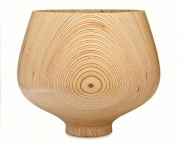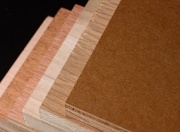Difference between revisions of "Plywood"
| Line 28: | Line 28: | ||
| face and back sheets of wood with a medium-density fiberboard (MDF) core | | face and back sheets of wood with a medium-density fiberboard (MDF) core | ||
|- | |- | ||
| − | | | + | | Oriented strand board |
| − | | Also known as wafer board, | + | | Also known as wafer board, OSB has a patchwork design with a variance of shapes, sizes, and colors of wood chips glued together. |
|- | |- | ||
| − | | | + | | Pressure treated plywood |
| − | | | + | | Contains chemicals to inhibit mold and mildew; will last for years without paint or any type of protective coating. |
|} | |} | ||
==== Labeling of Commercial plywood ==== | ==== Labeling of Commercial plywood ==== | ||
Revision as of 10:40, 10 November 2024
Description
A layered assembly of hardwood or softwood veneers bonded together at right angles with an adhesive. Plywood was originally called scale boards in a 1865 US patent. In the nineteenth century, plywood was manufactured from hardwoods (Maple, Birch, etc.) and used by furniture makers for concealed parts such as drawer bottoms. By the beginning of the 20th century, plywood was used for doors, seats, and desk tops. Douglas fir softwood plywood was first made in 1905; southern pine became extensively used in 1964 for softwood plywood. Plywood has been used in airplanes, automobiles, and house construction. Early panels were adhered with Hide glue, Blood glue, Cassava flour, Casein glue, and Soybean glue. In 1935, plywood was made with synthetic thermosetting formaldehyde adhesives (Phenol formaldehyde, and Urea formaldehyde). By 1939 Melamine formaldehyde resins were used and a few years later Resorcinol adhesives were also in use. At one point, water-resistant phenol formaldehyde adhesives were used for exterior-use plywood and urea formaldehyde resins were used in interior-use plywood, but concerns for emissions from both of the glues have resulted in the use of low formaldehyde-emitting glues systems that are denoted by an "E" rating and/or the code ANSI/HPVA HP-1-2016 on the back. These designations indicate the plywood passed federal and state regulations which allow a volatile emission rate of up to 0.3 ppm.
Plywood has a high strength-to weight ratio, is resistant to splitting, can be molded into compound curves, and is more dimensionally stable than solid wood. Various types of plywood are available:
| Plywood options | Description |
|---|---|
| Softwood | generally made from pine, fir, spruce and often consists of the same species of wood throughout the board. Sitka spruce is the preferred wood due to its lower resin content; Douglas fir may be more readily obtained and is preferable to pine |
| Hardwood | outer veneers of hardwood plywood are often birch, oak, cherry, maple, etc. The veneer core can be made from particle board, MDF, or a lumber core. Birch is preferred due to its lower acid content. Oak and cedar are not used because of its high acidity. |
| Veneer core | several thin sheets of wood called veneers bound together with an adhesive. The grains of the adjacent veneers are arranged at right angles with the face grain parallel to the panel length. After the adhesive is applied to the core veneers, it is cured in a hot press under high temperature and pressure. |
| Particle board core | particleboard between face and back sheets of wood |
| Lumber core | face and back sheets of wood with a solid lumber core between. |
| MDF core | face and back sheets of wood with a medium-density fiberboard (MDF) core |
| Oriented strand board | Also known as wafer board, OSB has a patchwork design with a variance of shapes, sizes, and colors of wood chips glued together. |
| Pressure treated plywood | Contains chemicals to inhibit mold and mildew; will last for years without paint or any type of protective coating. |
Labeling of Commercial plywood
| Grades of plywood | Description (softwood=A-D; hardwood=A1-D4) |
|---|---|
| A; A1 | A-grade plywood is the highest quality. While it will cost more, the time savings can be worth it for projects that will be visible to the eye. This type of plywood is smooth and easy to paint. |
| B; B2 | B-grade plywood usually has minor flaws that may require small repairs. It is slightly less smooth |
| C; C3 | C-grade plywood has more visible flaws and knots up to 1.5 inches in diameter. |
| D; D4 | D-grade plywood can have large flaws and knots up to 2.5 inches in diameter. This is typically the cheapest grade of plywood veneer |
| X | moisture resistant |
The first letter refers to the grade of the face of the plywood, and the second letter refers to the back. Therefore, “AB” plywood would have an A-grade face veneer and a B-grade back sheet. CDX-grade plywood is an inexpensive plywood material, which is made of the two lowest grades, C and D. The X signifies that this material can withstand some exposure to moisture. CDX is often times used for creating work tables and storage units.
Synonyms and Related Terms
laminated wood; Holzwerkstoff (Deut.); contrachapado (Esp.); tripley (Esp.); contreplaqué (Fr.); compensato (It.); triplex (Ned.); multiplex (Ned.); sklejka (Pol.); contraplacado (Port.); veneered construction; Plyshield; Haskelite; Harbord; Plankweld; Plycrete; Plymetal; Weldtex; Weldwood; scale board
Collection risks
Some plywoods contain Urea formaldehyde adhesives which emit Formaldehyde.
Working Properties
Softwood plywood is typically made from Cedar, Douglas fir, SPF (Spruce/Pine/Fir) or Redwood. It is typically used in home construction for roofing and flooring as well as for fencing, and boxes.
Hardwood plywood is made from dicot trees (Beech, Oak, Mahogany) to produce high strength, damage-resistant boards.
Veneer plywood is faced with more expensive hard woods such as Ash, Oak, Birch, Maple, Mahogany, Rosewood or Teak.
For additional information, see:
- AIC Conservation Wiki: Using Plywood in Exhibit Case Construction
Resources and Citations
- Wikipedia: https://en.wikipedia.org/wiki/Plywood (accessed April 2020)
- Dictionary of Building Preservation, Ward Bucher, ed., John Wiley & Sons, Inc., New York City, 1996
- Thomas C. Jester (ed.), Twentieth-Century Building Materials, McGraw-Hill Companies, Washington DC, 1995
- Encyclopedia Britannica, http://www.britannica.com Comment: wood" [Accessed October 31, 2001].
- R. J. Gettens, G.L. Stout, Painting Materials, A Short Encyclopaedia, Dover Publications, New York, 1966
- G.S.Brady, Materials Handbook, McGraw-Hill Book Co., New York, 1971 Comment: p. 618
- Ralph Mayer, A Dictionary of Art Terms and Techniques, Harper and Row Publishers, New York, 1969 (also 1945 printing)
- Caring for your Collections, Arthur W Schulz (ed.), Harry N. Abrams, Inc. , New York, 1992
- Pam Hatchfield, Pollutants in the Museum Environment, Archetype Press, London, 2002
- Richard S. Lewis, Hawley's Condensed Chemical Dictionary, Van Nostrand Reinhold, New York, 10th ed., 1993
- Theodore J. Reinhart, 'Glossary of Terms', Engineered Plastics, ASM International, 1988
- Random House, Webster's Encyclopedic Unabridged Dictionary of the English Language, Grammercy Book, New York, 1997
- The American Heritage Dictionary or Encarta, via Microsoft Bookshelf 98, Microsoft Corp., 1998

